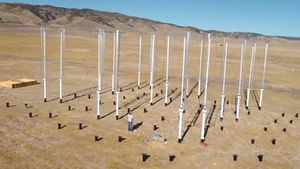Germany/Wind Turbine: Difference between revisions
Alex Shure (talk | contribs) No edit summary |
Alex Shure (talk | contribs) No edit summary |
||
| Line 70: | Line 70: | ||
* http://www.tinytechindia.com/windenergy.htm | * http://www.tinytechindia.com/windenergy.htm | ||
==Sources== | |||
<references /> | <references /> | ||
Revision as of 23:08, 22 March 2012
We want to develop an open source wind turbine with an agile open collaboration.
Team
If you want to participate add your name and how you want to participate here, also please introduce yourself in the Google Group.
- Alex Shure – research and development
- Nikolay Georgiev - communication and organization
Roadmap / Log
- 20120211 Alex Shure Start of "Open Agile SCRUM GVCS machine development" mailing list, Nikolay Georgiev sent an E-Mail to some OSE:E members - We begin to discuss the OSE:E project of constructing a wind turbine
- 20120222 Alex Shure First online meeting on the OSE:E project "develop a wind turbine" in mumble
- 20120311 Alex Shure I had a 6 hour meeting with a German wind turbine technician who works in QS where we discussed various aspects, advantages and disadvantages of horizontal and vertical axis wind turbines.
Requirements
The wind turbine should be designed according to the OSE Core Values.
Design outlines
We want to design a rather small VAWT, resulting in the following advantages:
- + DIY! People should be able to build them! -> KISS principle
- + less moving parts
- + does not necessarily have to be elevated, can stand on the ground
- + collects wind from every direction: no need for a directional control (+less mechanics, electronics)
- + has a smaller footprint
- + easier to design
- + way more easy to build
- + does not need a variable pitch control for high wind speed/ high power designs
- + uses cheaper materials, less bearings and axles, less machining operations
- + maintenance is easier, as the generator is on the ground, no need for a lift or a breakdown of the turbine head
- + a modular design is possible in a certain range (e.g. building it higher/longer in any direction)
- + does not necessarily need moldings or 3D shapes like sophisticated VAWT turbine blades
- - lower rpm at the same rotor diameter, at the same wind surface area due to the partly reversed draft of the wings but:
- + can have a small diameter but a rather large height, thus more torque and more rpm
Main disadvantage against a horizontal axis wind turbine:
- - less power output compared to a sophisticated HAWT design if wind direction does not change often and turbulence is low
A small form factor yields the following advantages:
- + easier maintenance
- + mobility, less weight
- + smaller impact on the environment/nature
- + lower system voltage and lower currents, less risky to operate
- + a smaller power rating results in a less complicated generator and inverter design
- + batteries can be charged quick&dirty with a simple charging circuit from a small wind turbine, which would not be possible with a high power wind turbine
and the following disadvantages:
- - less efficient
- - more physical weight per sourced energy (kg/kW)
If a larger energy source is required, we connect multiple wind turbines in a local grid -> distributed energy sourcing, a 'wind farm' consisting of VAWTs:
Dabiri carried out field tests in the summer of 2010 at an experimental farm known as the Field Laboratory for Optimized Wind Energy (FLOWE), which houses 24 10-meter-tall, 1.2-meter-wide VAWTs. In the field tests, which used six VAWTs, Dabiri and his colleagues measured the rotational speed and power generated by each of the turbines when placed in a number of different configurations. One turbine was kept in a fixed position for every configuration, while the others were on portable footings that allowed them to be shifted around. They found that the aerodynamic interference between neighboring turbines was completely eliminated when all the turbines in an array were spaced four turbine diameters (roughly five meters or 16 feet) apart. In comparison, propeller-style HAWTs would need to be spaced 20 rotor diameters apart - which equates to a distance of more than one mile for the largest wind turbines currently in use - for the aerodynamic interference to be eliminated. The six VAWTs generated from 21 to 47 watts of power per square meter of land area, while a comparably sized HAWT farm generates just two to three watts per square meter.[1]
Other links
- non OS example 1
- http://www.fundamentalform.com/html/involute_wind_turbine.html
- http://www.daswindrad.de/forum/viewtopic.php?f=2&t=21
- http://www.tinytechindia.com/windenergy.htm
